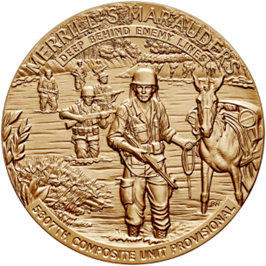
copyright © Wartime Heritage Association 2012-2024
Website hosting courtesy of Register.com - a web.com company
Wartime Heritage
ASSOCIATION
Remembering World War II
Name:
Leroy Elmer Brown
Rank:
Private First Class
Service Number:
31019775
Service:
5307th Composite Unit (Provisional) /
Merrill’s Marauders, US Army
Awards:
Bronze Star, Purple Heart
Date of Birth:
May 26, 1919
Place of Birth:
Revere, Suffolk County, Massachusetts
Date of Enlistment:
March 6, 1941
Place of Enlistment:
Boston, Massachusetts
Age at Enlistment:
21
Address at Enlistment:
Revere, Suffolk Co., Massachusetts
Marital Status:
Single
Occupation:
Attendant at filling [gas] station
Date of Death:
April 1, 1944
Age:
24
Cemetery:
Pine Grove Cemetery, Lynn, Massachusetts
Grave:
Hickory Avenue, Lot 105, Grave 2
Leroy Elmer Brown was the son of Edward Reed Brown (born 1887-1923), of Kings County, Nova Scotia, and
Annie Elizabeth Cameron (1876-1975), born in Goshen, Guysborough Co., NS. His father worked as a shoe
cutter in a shoe factory (1920 in the United States).
Leroy’s brother James Franklin Brown served in the US Navy in 1945, and his brother Edward G. Brown served
with the Seabees, the Naval Construction Battalions (or CB’s) of the Naval Construction Force, in the US Navy
in WWII as well.
Leroy completed his US Draft registration on October 16, 1940, working for H.V. Dunifer as a gas station
attendant at 1030 Broadway in Revere. After enlisting in 1941, Leroy was assigned to the US Army’s 5307th
Composite Unit (Provisional), codename as Unit Galahad, or Merrill’s Marauders (named after Frank Merrill).
They were a long range penetration special operations jungle warfare group, which became known for its
deep-penetration missions behind Japanese lines, often engaging Japanese forces superior in number.
From February to May 1944, the operations of the Marauders were closely coordinated with those of the
Chinese 22d and 38th Divisions in a drive to recover northern Burma and clear the way for the construction of
the Ledo Road, which was to link the Indian railhead at Ledo with the old Burma Road to China; a vital supply
route.
Beginning in March 1944, the Japanese had attempted to invade India at Imphal and Kohima, but these were
major defeat for the Japanese.
Informed by the British that the situation in Imphal, India was
under control, Stilwell wanted to launch a final assault to capture
the Japanese airfield at Myitkyina, Burma. Always guarded against
the potential for interference by the British, General Stilwell did
not coordinate his plans with Admiral Mountbatten, instead
transmitting separate orders to his Chinese forces and the
Marauders. The men took a brief rest at Shikau Gau, a jungle
village clearing where they bartered with the native inhabitants for
fresh eggs and chickens with an issue of 10-in-one and C rations.
The Marauders also took the opportunity to sunbathe in an attempt
to control the onset of various fungal skin diseases. Now down to a
little over 2,200 officers and men, the 5307th began a series of
battles on the march to Myitkyina.
In April, the Marauders were ordered by General Stilwell to take up a blocking position at Nhpum Ga and hold
it against Japanese attacks, a conventional defensive action for which the unit had not been equipped. At
times surrounded, the Marauders coordinated their own battalions in mutual support to break the siege after a
series of fierce assaults by Japanese forces. At Nhpum Ga, the Marauders killed 400 Japanese soldiers, while
suffering 57 killed in action, 302 wounded, and 379 incapacitated due to illness and exhaustion. Of the unit's
200 mules, 75 were killed by artillery and mortar fire. A concurrent outbreak of amoebic dysentery
(contracted after linking up with Chinese forces) further reduced their effective strength. Although the
Marauders had previously avoided losses from this deadly disease (in part by use of halazone tablets and strict
field sanitation procedures), their encampment with Chinese infantry, who used the rivers as latrines, proved
their undoing (the Chinese troops, who always boiled their drinking water, were not seriously affected).
Private First Class Leroy Elmer Brown was
killed in action in Nhpum Ga in Kamaing,
Kachin, Burma, on April 1, 1944.
Leroy E. Brown was interred at the Pine Grove
Cemetery in Lynn, Massachusetts.
Leroy Elmer Brown



Merrill's Marauders Congressional Gold
Medal (reverse)





- World War I - Menu
- WWI Stories and Articles
- Photos - Yarmouth Soldiers
- Selection of World War I Songs
- WWI Casualties of Yarmouth, NS
- Those Who Served - Yarmouth, NS
- WWI Casualties Digby Co. NS
- WWI Casualties Shelburne Co. NS
- Merchant Mariners (1915) Yarmouth, NS
- Canadian Forestry Corps - Non Yarmouth Birth/Residence Enlistments
- US Draft Registry - Yarmouth NS Born


- World War II - Menu
- WWII Stories and Articles
- Telegraphist Air Gunners
- WWII Casualties of Nova Scotia
- US Casualties with NS Connection
- Far East/Pacific Casualties with NS Connection
- Merchant Navy Casualties Nova Scotia
- Nova Scotia WWII Casualties Holten Canadian War Cemetery
- D-Day Casualties - Nova Scotia
- CANLOAN Program Casulaties - Nova Scotia
- Battle of the Bulge Casualties - Nova Scotia
- WWII Casualties Yarmouth NS
- Yarmouth Casualties - RCAF RAF Canadian Army WWII
- Yarmouth Co., Marrages WWII
- Casualties Non-Born/Residents with Connection to Yarmouth Co., Nova Scotia.
- WWII Casualties Digby Co., NS
- Non-Nova Scotian WWII Casualties Buried in Nova Scotia
- WWII RCAF Casualties Aged 16-18
- Brothers/Sisters Who Served - World War II













